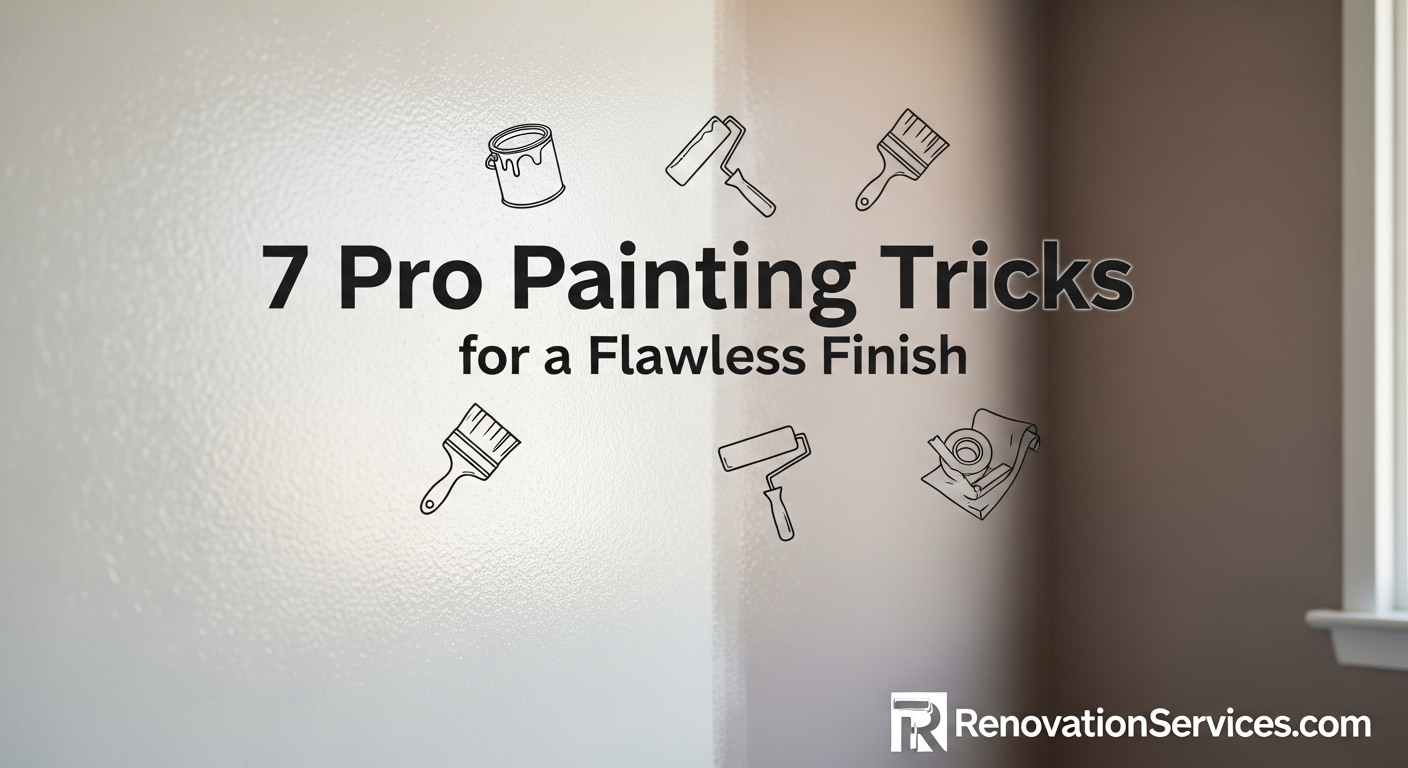7 Painting Tricks That Will Make You a Level 100 Master
Discover the professional secrets that separate amateur results from flawless finishes. This guide expands on seven game-changing techniques for your next painting project.
Get a Free Painting EstimateLast Updated: September 26, 2025
Every DIY painter strives for that elusive, professional-grade finish—the kind with razor-sharp lines, perfectly smooth walls, and no trace of errors. While our comprehensive guide on how to paint a room covers the essential process, there are a handful of advanced tricks that seasoned pros use to elevate their work from good to flawless. These aren’t complicated procedures requiring expensive equipment; they are simple, ingenious solutions to the most common painting frustrations.
This article dives deep into seven of these “Level 100” techniques, inspired by the clever hacks shared by professionals and experienced DIYers. We’ll go beyond the “what” and explore the “why” and “how” of each trick, expanding on the core concepts to give you a master’s understanding. From guaranteeing zero paint bleed under your tape to patching a hole without a speck of dust, these methods will save you time, reduce frustration, and deliver a result that looks like you hired one of our expert Brooklyn crews. Prepare to transform your approach to painting, because as any expert will tell you, the debate over whether expensive paint is worth it often comes down to technique, not just materials.
7 Pro Tricks at a Glance
- Seal Tape Edges: Use clear caulk for absolutely perfect, bleed-proof lines.
- Patch in a Bag: Mix and apply plaster from a plastic bag for a clean, efficient repair.
- De-Lint New Rollers: A simple piece of packing tape is the key to a fuzz-free finish.
- Mask with Vaseline: Protect complex hardware from paint splatters with a thin layer of petroleum jelly.
- Create a Drip Shield: A plastic lid on your brush handle keeps you clean when painting ceilings.
- DIY Roller Cleaner: A bent coat hanger scrapes excess paint, saving money and speeding up cleanup.
- Tape Your Brush: Modify a standard brush for detail work by taping the bristles.
Trick #1: The Ultimate Weapon for Crisp Lines – Sealing Tape with Caulk
The single most visible indicator of an amateur paint job is a wobbly, bleeding cut-in line. Even the highest quality painter’s tape can fail on textured walls, allowing paint to seep underneath. The professional’s secret to guaranteeing a perfect line every single time is to create an impenetrable barrier using clear, paintable acrylic latex caulk. This simple addition to your process elevates your results from decent to truly professional, a standard necessary for any quality renovation, which often requires knowledge on how to get a building permit in New York.
The Principle: Filling the Micro-Gaps
No matter how firmly you press down your painter’s tape, microscopic gaps will exist between the tape’s edge and the wall’s surface, especially on walls with any texture (“orange peel” or knockdown). Paint, being a liquid, will exploit these gaps through capillary action, resulting in bleeding. This trick works by filling and sealing these gaps with a flexible, paintable material *before* you apply your color. The caulk forms a dam that the paint cannot cross.
Interactive Tool: Tape Adhesion Troubleshooter
Getting tape to stick and seal properly is half the battle. Select your wall condition to get a pro tip.
Step-by-Step Execution
- Apply Your Tape: Lay down your high-quality painter’s tape as you normally would along trim, ceilings, or accent wall lines. Use a putty knife or credit card to press the edge down firmly.
- Apply the Sealant: For this, you’ll need to know how to use a caulking gun. Squeeze a very thin bead of clear, paintable acrylic latex caulk along the edge of the tape that will be painted. You need very little—just enough to bridge the gap.
- Smooth the Bead: Dip your finger in water and run it along the bead, pressing the caulk into the tape’s edge. Wipe away virtually all of the excess with a damp rag. The goal is to leave an invisible seal, not a visible caulk line.
- Paint Immediately: While the caulk is still wet, you can begin painting. Apply your paint as usual, brushing over the sealed edge of the tape.
- The Reveal: Wait for the paint to be dry to the touch (but not fully cured) and peel the tape away at a 45-degree angle. You’ll be left with a line so sharp it looks like it was cut with a laser. This technique is far superior to the common advice on how to paint trim without tape for non-professionals.
Interactive Tool: Caulk vs. Silicone – Which Sealant to Use?
While similar, caulk and silicone have key differences. Choose your application to see the professional recommendation.
Trick #2: The No-Mess, No-Waste Method for Wall Patching
Patching small nail holes or screw anchors is a fundamental part of wall preparation, but it can be a surprisingly messy process. Mixing powdered joint compound (plaster) creates dust, and scooping pre-mixed spackle from a tub can lead to waste and dried-out product. The plastic bag method solves all of these problems at once, making it a perfect technique for the essential steps of wall prep.
The Principle: Containment and Control
This technique transforms a simple plastic bag into a self-contained mixing vessel and a precise application tool. By containing the mixing process, you eliminate airborne dust. By turning the bag into a dispenser similar to a pastry bag, you gain exceptional control over how much compound you apply, forcing it deep into the hole with minimal excess on the surrounding wall. This means less sanding and a cleaner job site, a standard we uphold in all our commercial painting projects. Remember, when dealing with older homes, especially in NYC, you must be aware of potential hazards like lead paint, a topic the EPA provides extensive resources on.
Interactive Tool: Patch Compound Estimator
Estimate how much patching material you’ll need for your small repairs.
Step-by-Step Execution
- Choose Your Bag: Select a sturdy, quart-sized or gallon-sized freezer bag. Avoid thin sandwich bags that could puncture.
- Add Ingredients: For powdered compound, add the plaster first, then slowly add small amounts of water. For pre-mixed compound, scoop a manageable amount into the bag.
- Seal and Mix: Squeeze out most of the air and seal the bag securely. Knead the bag with your hands until the compound is perfectly smooth and has the consistency of peanut butter. There should be no lumps or dry spots.
- Create the Applicator: Push the mixed compound into one corner of the bag. Use scissors to snip a tiny piece off that corner—start small, you can always make it bigger.
- Apply with Precision: Aim the small opening into the nail hole or crack and squeeze gently. The compound will be forced deep into the cavity. Fill it slightly proud of the wall surface to account for minor shrinkage.
- Smooth and Finish: Use a flexible putty knife to smooth the patch flush with the wall. Because the application was so precise, you’ll have very little excess to clean up. Once dry, a quick, light sanding is all that’s needed. For achieving a perfectly smooth surface over larger areas, consider learning about skimming walls for beginners.
Interactive Tool: Patch Dry Time Estimator
Drying time is crucial before sanding. Select your compound type for an estimate.
Trick #3: The 10-Second Solution for a Lint-Free Finish
You’ve done perfect prep work and are rolling on your beautiful new color, only to see tiny, fuzzy specks marring your finish. This is roller lint, and it’s a common plague when using a brand-new roller cover. These loose fibers from the manufacturing process will shed and embed themselves in your wet paint, creating a textured, unprofessional look. The fix is incredibly simple and takes less than a minute.
The Principle: Proactive Removal
Instead of trying to pick fuzz out of wet paint, the professional approach is to remove it from the source *before* the roller ever touches a paint tray. The adhesive on a strong piece of tape is perfect for grabbing and pulling away all the loose, poorly-adhered fibers from the roller nap, leaving only the securely attached material behind.
Interactive Tool: Roller Nap Selector
Using the correct roller nap (thickness) is key to good coverage. Select your wall surface to get a recommendation.
Step-by-Step Execution
- Choose Your Tape: The best options are high-tack tapes like packing tape, duct tape, or even high-quality painter’s tape.
- Wrap the Roller: Before mounting the cover on the roller frame, wrap the tape around it with the sticky side facing in, covering the entire surface of the nap.
- Press Firmly: Rub the tape firmly all over the roller to ensure the adhesive makes good contact with the fibers.
- Rip It Off: Briskly peel the tape off. You will be surprised to see a visible layer of fuzz stuck to the tape.
- Repeat if Necessary: For cheaper rollers, you may want to repeat the process with a fresh piece of tape to be thorough.
- Optional Wash: For an even better result, some pros will give the de-linted roller a quick rinse with water and a little soap, then let it dry completely. This removes any remaining microscopic dust.
Trick #4: The Painter’s Masking Fluid – Protecting Hardware with Petroleum Jelly
Ideally, all hardware—doorknobs, hinges, light fixtures, cabinet pulls—should be removed before painting. But sometimes, that’s not feasible. An old hinge might be painted over and frozen in place, or a fixture might be too complex to remove. Taping these intricate shapes is a frustrating and often ineffective exercise. Petroleum jelly (like Vaseline) offers a brilliant alternative.
The Principle: Creating a Non-Adherent Barrier
Paint is formulated to adhere to clean, dry surfaces. Petroleum jelly is an oily, non-drying substance that creates a slick barrier paint simply cannot stick to. By applying it precisely to the surface you want to protect, you create a “mask” that allows you to paint right up to the edge without fear. When the paint is dry, the jelly—and any paint on top of it—wipes away cleanly.
Interactive Tool: Masking Method Advisor
Not sure how to protect your hardware? Select the item you’re painting around.
Step-by-Step Execution
- Clean the Hardware: Ensure the hardware is clean and free of dust.
- Apply with Precision: Using a cotton swab or a small artist’s brush, apply a thin, even layer of petroleum jelly to the entire surface of the hardware you want to protect. Be careful not to get it on the surface you intend to paint.
- Paint as Usual: Paint your trim, door, or wall. Don’t worry if your brush touches the protected hardware; the jelly will prevent the paint from sticking.
- Wipe Away: Once the paint is dry to the touch, use a clean rag or paper towel to wipe the petroleum jelly off the hardware. The paint that was on top of it will come right off, revealing a clean, paint-free surface underneath.
Trick #5: The No-Drip Ceiling Hack – A DIY Brush Shield
Painting a ceiling or any overhead surface is a guaranteed way to end up with paint on your hands, arms, and face. As you cut in the edges, gravity inevitably pulls paint down the handle of your brush. While professional tools exist for this, a simple, free solution can be found in your recycling bin. This is a must-know technique for anyone following a guide to painting a ceiling.
The Principle: Simple Gravity Interception
This trick works by creating a physical barrier—a small “umbrella”—that intercepts paint drips before they can run down the brush handle. A plastic lid provides the perfect shape and material to catch the drips, keeping your hands clean and saving you from a frustrating cleanup.
Interactive Tool: Ceiling Paint Finish Advisor
The right sheen hides imperfections. How would you describe your ceiling surface?
Step-by-Step Execution
- Find a Lid: A lid from a yogurt container, sour cream tub, or a coffee can is ideal. It should be a few inches wider than your brush handle.
- Create the Opening: Carefully use a utility knife to cut a small “X” in the center of the lid.
- Mount on Brush: Push the handle of your paintbrush through the “X” from the bottom side. The plastic will flex to create a snug fit around the ferrule (the metal part) of the brush.
- Paint Drip-Free: As you paint the ceiling, the lid will catch any drips, keeping you clean and allowing you to focus on creating a perfect line.
Trick #6: The Frugal Pro’s Tool – A DIY Roller Squeegee
A surprising amount of paint remains in a roller cover even after you’ve finished rolling. Washing this paint down the drain is wasteful and bad for the environment. While you can buy curved multi-tools to squeegee out this excess, a simple piece of wire works just as well, if not better.
The Principle: Concentrated Pressure
This hack creates a custom tool that applies even pressure around the circumference of the roller nap. By fitting the curve of the roller perfectly, the wire acts as a squeegee, scraping the paint out of the deep fibers of the nap and forcing it back into the can for later use. This can recover a significant amount of paint and makes the final cleanup process much faster. Proper tool use and safety, especially when working on ladders, is always paramount, as emphasized by OSHA’s safety guidelines.
Interactive Tool: Paint Cleanup Solvent Guide
Using the wrong cleaner can ruin your tools. What kind of paint did you use?
Step-by-Step Execution
- Source Your Wire: A standard wire coat hanger is the perfect material.
- Cut and Bend: Using pliers, cut a straight section of the hanger. Bend this section into a tight “U” shape. The curve of the “U” should be slightly smaller than the diameter of your roller cover.
- Squeegee the Paint: Hold the roller over your open paint can. Place the curved part of your wire tool at the top of the roller and, pressing firmly, drag it downwards. A thick stream of paint will be squeezed back into the can.
- Repeat and Rotate: Rotate the roller and repeat the process until no more paint comes out. You’ll be left with a roller that is merely damp, making the washing process incredibly fast and easy.
Trick #7: The On-the-Fly Detail Brush – Customizing with Tape
You’re in the middle of a job and encounter a narrow, tricky spot—like the space between a cabinet and a wall—and your standard 2.5″ angled brush is just too bulky. Instead of running to the store for a smaller artist’s brush, you can modify the tool you already have in your hand in seconds. This is a perfect example of the ingenuity required for complex custom cabinet painting and detailed trim work.
The Principle: Reshaping and Stiffening
This trick uses the tension of painter’s tape to physically compress the bristles of a brush. By wrapping the tape around the lower half of the bristles, you force them into a narrower, more compact shape. This not only makes the brush’s profile thinner but also slightly stiffens the bristles, giving you more chisel-like control for precision work.
Interactive Tool: Best Brush for the Job
While you can modify a brush, starting with the right one is best. What are you painting?
Step-by-Step Execution
- Start with a Clean Brush: This works best on a clean, dry brush.
- Wrap the Bristles: Take a piece of high-quality painter’s tape and wrap it tightly around the bristles, starting about halfway down from the ferrule (metal band) and wrapping towards the tip.
- Control the Shape: The tighter you wrap, the narrower and stiffer the brush tip will become. You can create a fine, flat edge perfect for getting into tight corners.
- Paint with Precision: Load the tip of your newly modified brush with a small amount of paint and use it for your detail work.
- Remove When Done: When you’re finished with the detail work, simply peel off the tape, and your brush returns to its original shape, ready for normal use after cleaning.
Interactive Tool: Project Time Estimator
Get a rough estimate of how much time these pro tricks might add to your project compared to a standard approach.
Interactive Tool: Essential Safety Gear Checklist
A professional job is a safe job. Click to check off the safety gear for your project.
- Safety Glasses or Goggles
- Dust Mask (especially for sanding)
- Respirator (for oil-based paints or poor ventilation)
- Nitrile Gloves
- Sturdy, properly-placed ladder
Ready to Paint Like a Master?
Incorporating these seven tricks into your routine will dramatically improve the quality of your work, reduce frustration, and give you a final product you can be proud of. But sometimes, the best trick is knowing when to call in the experts. For projects that require a guaranteed professional touch, hiring a professional painter is the surest path to perfection. Contact Renovation Services for a free estimate on your next project in Manhattan, Brooklyn, or anywhere in NYC.






